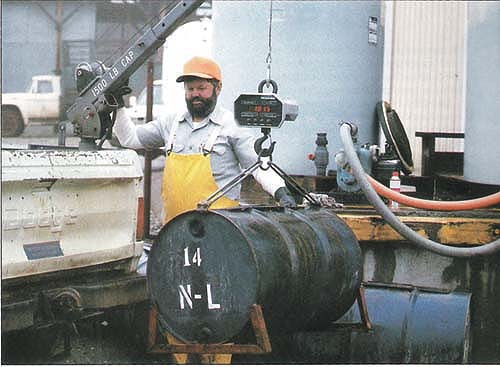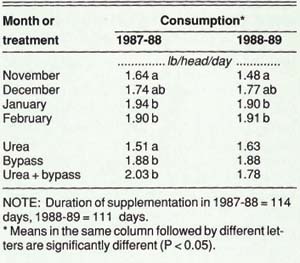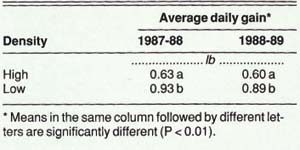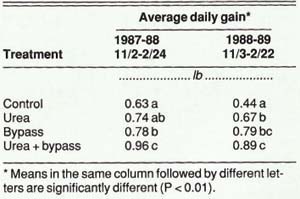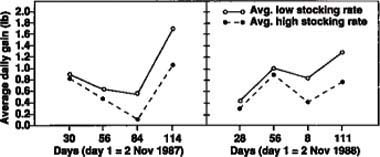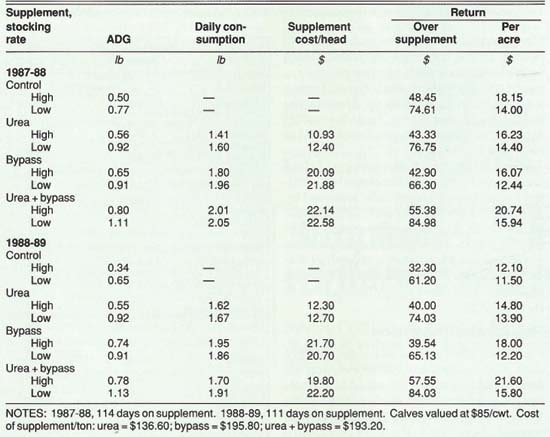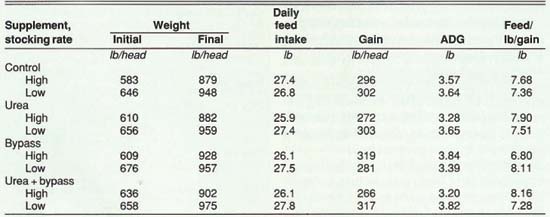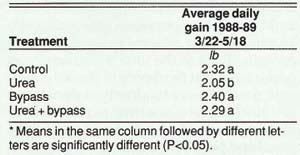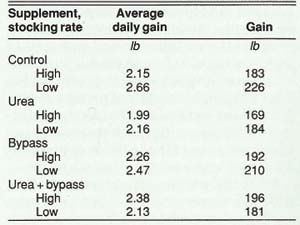All Issues
Supplements evaluated for wintering range calves
Publication Information
California Agriculture 44(2):12-15.
Published March 01, 1990
PDF | Citation | Permissions
Abstract
In two range feeding trials to evaluate supplemental nitrogen and/or bypass protein source and stocking densities, calves at a low density gained more weight than high-density groups. Dollar return during the supplementation phase, however, was highest from high-density groups fed a combination of urea and corn gluten meal.
Full text
California annual rangeland forage is generally of poor quality in the fall and in short supply during the winter. During those periods, supplements are typically provided to wintering calves to correct nutrient deficiencies and improve performance, maintain health, and prevent death loss.
Supplemental nutrients may be provided in many forms, the most common being hay, meals, pellets, cubes, liquids, and blocks. Supplements are usually high in nonprotein nitrogen such as urea, which aids fiber digestion and microbial growth. In many situations, however, urea supplementation may not meet the protein requirements of growing calves. Dietary protein may be digested to a variable degree in the rumen or may be entirely degraded. Protein that is not digested in the rumen, called bypass or escape protein, passes to the lower tract and is either digested postruminally or excreted in the feces. The supply of protein to the small intestine consists of the dietary protein that bypasses ruminal degradation plus the microbial protein synthesized within the rumen. Calves fed supplements that contain bypass protein may gain weight faster and more economically than those supplemented with urea.
Increased bypass protein, however, does not ensure increased animal growth, since: (1) microbial synthesis may provide adequate amino acids for growth; (2) bypass protein may be poorly digested in the small intestine; (3) the balance of amino acids in the postruminal protein may be poor; and (4) the energy supply or other nutrients may limit production.
In the past few years, liquid supplements have been based on urea and molasses. Now xanthin gums and clay are being used to suspend small particles such as minerals, natural protein supplements, and other desirable materials in liquid supplements.
We have been conducting studies to determine if steer calves would show a profitable growth response from supplemental nitrogen and/or bypass protein supplied during fall and winter growth of native range pasture. This report presents results from the first 2 years.
Materials and methods
Liquid supplements were evaluated as potential sources of bypass protein in supplementation programs for stocker calves on annual grasslands at the UC Sierra Foothill Range Field Station. We used 144 head of English breed and English crossbred steers averaging about 500 pounds.
Commercially formulated liquid supplement (molasses based mixtures) containing (1) urea, (2) bypass protein, or (3) urea plus bypass protein were used in the study and compared with (4) unsupplemented controls. Based on previous research, corn gluten meal was selected to supply bypass protein. Each of the four treatments was administered at two levels of stocking density: 6 steers were randomly assigned to a low stocking rate (one head per 5.33 acres) and 12 steers to a high stocking density (one head per 2.67 acres).
The experimental area (512 acres of cleared range) was divided into 16 fields, grouped in 4 blocks of 4 fields per block. In defining the blocks, we attempted to group fields that were similar (based on results of previous trials) in forage production characteristics. Animals were then assigned to one of the eight treatment groups at random. There were two replications per treatment. Subsequently, each treatment was assigned to one of the 16 fields so that each treatment appeared twice in each block.
As the trial progressed, animals (and thus treatments) were moved each month from one field to another so that they repeated no blocks over the 4-month supplementation period. In this way, each animal was in all four blocks, and each treatment was exposed equally to the various types of range represented in the four blocks. Blocking the fields into groups of four made it possible for each block to contain each treatment in each year of the trial.
Supplement lick tanks were weighed weekly and consumption recorded. Animals were fed on rangelands, followed by finishing under feedlot conditions in 1987-88. At the end of the supplementation period in 1988-89, the experimental animals grazed on rangeland during the spring season. A portion of the data was statistically analyzed as outline by SAS and a portion by CRUNCH.
Results and discussion
We have collected and analyzed 2 years of data. Consumption was lower during the first month on test and increased as animals became accustomed to the lick tanks (table 1). Consumption was lower in urea-supplemented steers than in the other two groups in 1987-88, but there were no significant differences among groups in 1988-89.
Stocking density had no effect on supplement consumption in either 1987-88 or 1988-89. However, stocking density did affect average daily gain (table 2).
The overall performance (cumulative average daily gain) of the steers during the supplemental feeding period is summarized in table 3. Steers offered supplements containing bypass protein tended to gain more rapidly than did the controls. Table 3 eliminates field bias by reporting cumulative average daily gain occurring over a four-field rotation. Calves fed the urea-corngluten meal combination gained more in both years than other treatments. Only in 1988-89 did urea treatment significantly improve performance over that of controls.
Monthly average daily gain results for the two stocking rates over all treatments (fig. 1) show more variation than those in table 3 (cumulative average daily gain) because of the short time between weigh periods. The high-stocking-rate groups had a lower average daily gain in both years. The yearly pattern was somewhat different, but in each year the difference between low and high stocking rate gradually increased through the season.
Results of overall performance and economic analysis of the trial by year (table 4) cover only the period of supplementation. Dollar return per acre favored the steers supplemented with the combination of urea plus corn gluten meal on the high stocking rate in both years.
Because of a drought in the 1987-88 feed year, the experimental animals were continued on supplements from February 24 to March 23, 1988, then shipped to the University of California, Davis, feedlot for finishing. Random subsets of each group were individually fed identical rations for feed intake, compensatory gain, and feed efficiency comparisons. The steers were fed to an estimated slaughter grade of low choice. The supplemental phase treatments had little influence on finishing phase gains (table 5).
In the 1988-89 trial, urea-supplemented calves gained significantly less than the other treatment groups during the nonsupplemental feeding period on spring range (table 6). Table 7 shows the overall performance of the steers during 1988-89. These figures cover only the nonsupplementation period.
Returns over supplement costs were higher per head for the low stocking rate fields because of higher average daily gains. Returns per acre, however, favored the higher stocking densities. Higher cumulative average daily gains resulted in higher returns in 1987-88 than in 1988-89. This result is due in part to differences in residual dry matter of the test fields at the onset of the trial.
Conclusions
In the two studies of stocking density and protein source in liquid supplements for weaned range calves, performance during the supplementation phase appeared to have little influence on gains during the nonsupplemental phase at feedlot. Steers in the low-stocking-density groups (one head per 5.33 acres) gained more weight than those in the high-stocking-density groups (one head per 2.67 acres) across all supplement treatments. As a result, groups at the lower stocking density returned more dollars per head. Dollar return per acre favored the high stocking density.
The high-density, urea-plus-bypass treatment provided the highest return per acre during the supplementation phase in both years. The cost of supplement used in this analysis does not consider labor expense.
Variations in overall average daily gains between years may be a reflection of residual dry matter differences at the onset of each trial.



